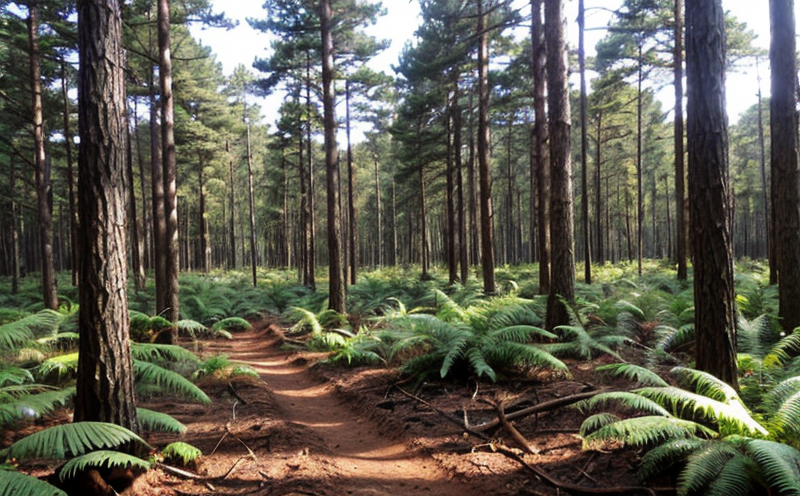Soil Carbon Content Testing
The measurement of soil carbon content is critical in understanding and managing forest ecosystems. Soil carbon plays a pivotal role in the health of forests by influencing nutrient cycling, water retention, and overall biodiversity. This service provides detailed analysis to quantify the amount of organic matter stored within the soil, which helps in assessing ecosystem resilience and productivity.
Understanding soil carbon content is essential for several stakeholders including environmental scientists, agriculturalists, and foresters. It aids in monitoring the impact of land management practices such as deforestation, afforestation, or reforestation projects. The accurate measurement of soil organic matter can also help in determining the potential for increased carbon sequestration within managed forests.
Our testing methodology adheres to international standards ensuring precision and reliability. We use advanced laboratory equipment designed specifically for soil analysis which includes but is not limited to, automated gravimetric methods, near-infrared spectroscopy (NIRS), and elemental analyzers. These techniques allow us to provide comprehensive reports that are invaluable for decision-making processes.
The importance of accurate soil carbon content testing cannot be overstated. It enables stakeholders to make informed decisions about land use practices which have significant implications for climate change mitigation efforts globally.
| Method | Description |
|---|---|
| Automated Gravimetric Methods | This involves drying the soil sample to constant weight, then burning it in an oxygen stream to convert all organic carbon into CO₂. |
| Near-Infrared Spectroscopy (NIRS) | An optical technique that measures the absorbance of near-infrared light by soil samples. |
By employing these cutting-edge techniques, we ensure our clients receive accurate and reliable results. Our team of experts works closely with each client to understand their specific requirements before conducting any tests. This ensures that the data collected is relevant to the particular needs of the project or research being undertaken.
The benefits of knowing soil carbon content extend beyond just scientific understanding; it has practical applications in agriculture and forestry too. For instance, farmers can use this information to optimize fertilization practices leading to improved crop yields while foresters can better plan sustainable harvesting strategies preserving long-term forest health.
Scope and Methodology
| Aspect | Description |
|---|---|
| Sample Collection | Field samples are collected following standardized protocols to ensure representativeness. |
| Preparation and Preservation | Samples undergo thorough preparation before analysis, including drying at specific temperatures. |
The methodology for soil carbon content testing is rigorous and involves multiple steps aimed at ensuring accuracy. Once samples are collected, they go through a series of preparatory stages which include sieving to remove large particles and homogenization for consistency. Following this, the samples are dried either in an oven or using freeze-drying methods depending on the moisture content.
Once prepared, the samples can be analyzed using various techniques as discussed earlier. Each method has its own advantages and limitations; therefore, our team selects the most appropriate technique based on the specific requirements of each project. For instance, if high precision is required for a long-term monitoring program, then automated gravimetric methods might be preferred over NIRS which offers faster turnaround times but slightly lower accuracy.
Industry Applications
The application of soil carbon content testing spans across various sectors including agriculture, forestry, environmental science, and climate change research. In agriculture, this service helps farmers understand the health of their soils which directly impacts crop yield and quality. By monitoring changes in soil organic matter over time, they can adjust their farming practices accordingly.
In forestry, accurate measurements aid in assessing carbon stocks within managed forests helping stakeholders comply with international agreements on climate change mitigation such as REDD+ (Reducing Emissions from Deforestation and Forest Degradation). This knowledge is crucial for forest managers aiming to enhance ecosystem services like biodiversity conservation, water regulation, and carbon storage.
For environmental scientists studying ecosystems, soil carbon content testing provides insights into the functioning of natural systems. It helps in identifying areas where intervention might be necessary to restore degraded lands or promote reforestation initiatives aimed at increasing global forest cover and combating climate change.
Use Cases and Application Examples
Agricultural Case Study:
One of our clients, a large-scale agricultural enterprise in North America, was looking to optimize their fertilization practices. By analyzing the soil carbon content across different fields, they identified significant variations between plots that had similar management practices but varying yields. Based on these findings, they were able to tailor their fertilizer application rates more precisely resulting in higher crop yields without increasing input costs.
Forestry Case Study:
A European timber company wanted to assess the carbon sequestration potential of its new plantation projects before commencing operations. Using our soil carbon content testing service, they obtained detailed data on current soil conditions which allowed them to predict future carbon storage capabilities accurately. This information was instrumental in selecting suitable tree species and planning appropriate silviculture practices ensuring long-term sustainability.





